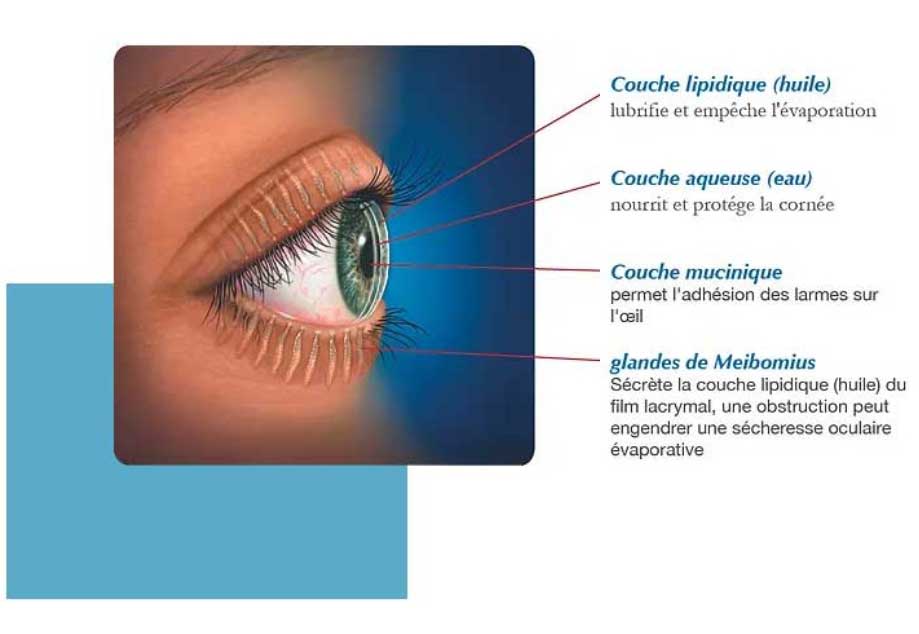Dry eye symptoms
All the explanations
What is tear film?
The tear film covers, lubricates and protects the eye. In other words, it’s absolutely essential for eye comfort!
This film consists of three layers:
– the mucinic layer, produced by mucus cells in the conjunctiva, enables tears to attach to the surface of the eye and cornea;
– the aqueous layer, produced by the lacrimal glands, is 98% water. It moisturizes and nourishes the cornea;
– the third layer, the lipid layer, is produced by the Meibomius glands in the eyelids.
It is expressed from the glands during the blink and limits tear evaporation. Blinking allows tears to spread evenly over the ocular surface.

Understanding dry eyes
Dry eyes may be due to a lack of tear production. This form is particularly common in post-menopausal women. But most of the time, it’s the result of a qualitative deficit in the tear film: the lipid layer, essential for maintaining the aqueous layer, is of insufficient quality or quantity, and tears evaporate too quickly. In over 80% of cases, the cause is a dysfunction of the Meibomian glands (DGM).
There are 30 to 40 Meibomian glands per eyelid. Located on the posterior surface of the eyelids, they emerge behind the eyelashes, on the free edge. They secrete meibum, a fatty substance composed mainly of triglycerides, which forms the lipid layer. By preventing evaporation of the aqueous layer, it keeps the eye hydrated and lubricated. When the meibomian glands malfunction, their secretions thicken, leading to occlusion of their orifices, a decline in the quality of the lipid layer and, ultimately, permanent atrophy of the meibomian glands.
What are the symptoms?
Ocular symptoms, including discomfort or visual disturbance (blurred vision), or both, remain a central feature of dry eye disease.
This leads to a sensation of sand grains in the corner of the eye, burning and itching. Irritation may be felt when blinking.
The eyes sometimes stick together in the morning (see blepharitis). Inflammation is a key element in dry eye, amplifying the symptoms.
These symptoms are intermittent and vary in intensity. They can be aggravated by prolonged visual exertion (reading, driving, screens) or in dry, dusty environments.
Conversely, they may decrease in a very humid environment…
Two points to watch out for
Be careful when wearing contact lenses:
the latter are the cause of lacrimal instability, and are often cited when looking for the causes of dry syndrome.
And watch out for incomplete blinking!
It’s a problem that’s impossible to detect with the naked eye, but one that is now well known to be involved in the development of dry eye, since each blink is the key to the expression of the Meibomius glands and the spreading of the tear film to cover the entire surface of the eye. This syndrome may even be the sole cause of dry eyes. If there are too many incomplete blinks, the lipid film cannot renew itself properly, leading to hyper-evaporation of tears and the symptoms described above. Meibum stagnates in the glands, blocking them and causing what’s known as “Meibomian gland dysfunction”, or MGD. This is the beginning of the vicious circle of dry eyes and glandular atrophy. This problem is getting worse with our lifestyles. Prolonged screen use, reading or driving lead to longer fixation and less frequent blinking. We blink 3 to 4 times less often when we’re on a screen, which means that the lipid part of the tear film is no longer sufficiently renewed.

